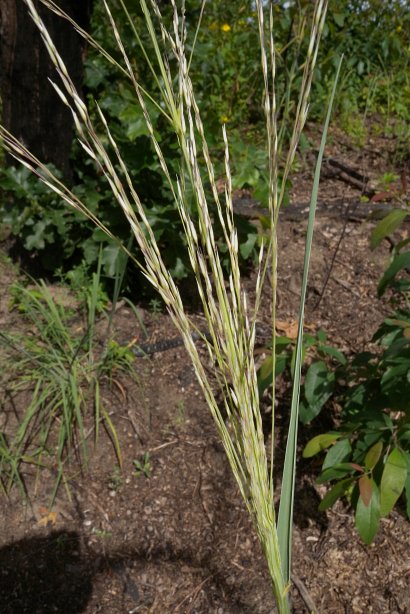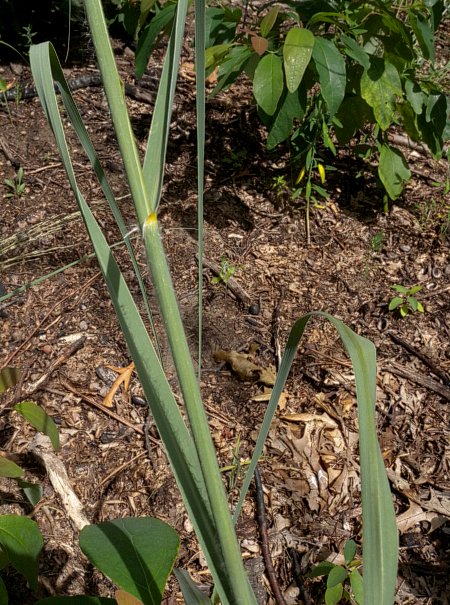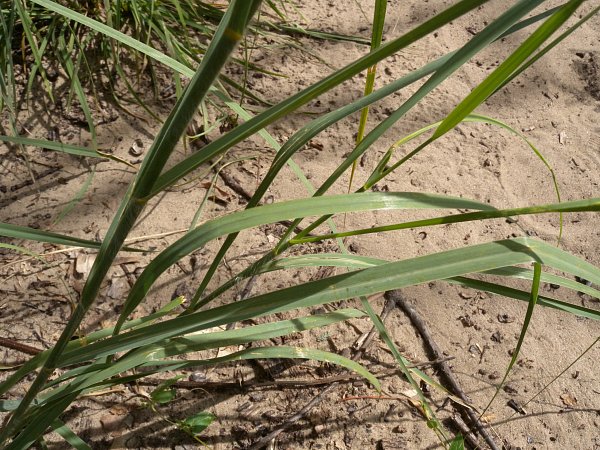
Secondary lateral branches are usually appressed along the lengths of primary lateral branches. The branches and central rachis of the panicle are straight, very slender, and glabrous, although the tip of the rachis sometimes nods. One-flowered spikelets develop from short slender pedicels. Each narrow spikelet is 6-7.5 mm. long and greenish white, consisting of a pair of glumes, a single lemma, a single membranous palet, and a perfect floret with 3 anthers and an ovary with a pair of stigmata. The glumes, lemma, and palet are narrowly lanceolate in shape and glabrous, except for a small tuft of fine hairs at the base of the lemma and palet. The glumes and lemma are single-veined, and their tips are acute (tapering to a point), but not awned. The glumes are unequal in length (3-5 mm. long versus 5-7.5 mm. long), while the lemma is typically 4.5-7.0 mm. long. The blooming period occurs from mid-summer to early fall. The florets are cross-pollinated by the wind. Afterwards, the florets are replaced by slender pale grains about 2.5-4.5 mm. long, which become mature during the fall. Disarticulation of the spikelets is above the glumes. The root system is fibrous and long-rhizomatous, often extending to a depth of 4-10'. Occasionally, clonal colonies of plants are produced.

Cultivation: The preference is full or partial sun, mesic to dry conditions, and sandy soil (from coarse sand to sandy loam). Most growth and development occur during the summer. Tolerance of drought is excellent.
Range & Habitat: The native Sand Reed is occasional in sandy areas in the northern half of Illinois, while in the rest of the state it is rare or absent (see Distribution Map). Habitats include upland sand prairies, sandy hill prairies, sand dunes, upper areas of beaches along Lake Michigan, upland sandy savannas, and openings in sandy woodlands. Sand Reed is one of the grasses that stabilizes sand dunes and sand blowouts. In upland wooded areas, it is associated with oak trees (especially Black Oak). In some upland sand prairies, this is the dominant grass.

Faunal Associations: Sand Reed is the host plant of a leafhopper, Flexamia grammica, and the adults of a spittlebug, Philaenarcys killa. Some species of grasshopper that are often found in barren sandy areas also feed on Sand Reed; they include such species as Eritettix simplex (Velvet-striped Grasshopper), Melanoplus foedus (Striped Sand Grasshopper), Mermiria bivittata (Two-striped Mermiria Grasshopper), Orphulella speciosa (Pasture Grasshopper), and Spharagemon collare (Mottled Sand Grasshopper); see the Grasshopper Table for a more complete list of these species. For hoofed mammalian herbivores (cattle, horses, sheep, deer, etc.), Sand Reed provides below-average forage. However, young plants are more palatable to such herbivores, and this grass will be grazed, regardless of its stage of development, when more palatable grasses and broad-leaved plants are hard to find. The Plains Pocket Gopher eats the leaves, stems (culms), and rhizomes. This burrowing animal is found in open sandy areas along the Illinois River and in the Kankakee sand region of Illinois, where Sand Reed occurs.

Photographic Location: An upland sandy savanna near Lake Michigan at the Indiana Dunes State Park in NW Indiana.
Comments: Sand Reed superficially resembles Panicum virgatum (Switch Grass), Calamagrostis canadensis (Bluejoint Grass), and other tall-growing grasses with single-seeded florets. It differs from most of these species by the tuft of fine hairs at the bottom of each lemma and palea, which may require a 10x hand lens to see (after the glumes have been removed). While Bluejoint Grass shares this characteristic, it differs from Sand Reed by the presence of awns on its lemmas. Other distinctive characteristics of Sand Reed are the pale color of its spikelets (greenish white or light tan), the relatively long length of its spikelets (6.0-7.5 mm.) among those spikelets that are single-seeded, and the presence of only a single prominent vein on each lemma and glume.